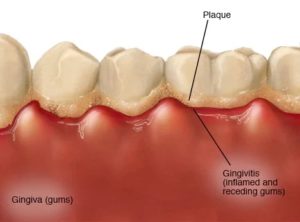Periodontal Disease
What Is Periodontal Disease?
 Periodontal disease is an infection of the gums, tissues and bone that support your teeth. It is also called gingivitis or gum disease.
Periodontal disease is an infection of the gums, tissues and bone that support your teeth. It is also called gingivitis or gum disease.
When your gums are healthy, they attach to your teeth tightly. When they are infected – or have gum disease – they pull away from your teeth and may become swollen and red. As gum disease gets worse, the tissues and bones that support your teeth can become damaged to the point that they can no longer support your teeth to a degree that your teeth may become loose and need to be removed.
That’s why it’s so important to take care of your gums and try to prevent gum disease, and to treat gum disease in its early stages. The more proactive you are, the better your chances of preventing tooth loss.
Could I Have Periodontal Disease?
Ask yourself these questions…
- Do your gums bleed when you brush or floss?
- Are your gums red (not pink), puffy, tender or swollen?
- Do your gums seem to to be soft and/or flabby?
- Do you constantly have bad breath?
- Do you often have a bad taste in your mouth that won’t go away?
- Do you notice spaces between your teeth increasing?
- Do any of your teeth feel loose?
If you answered yes to even one of these questions, it is possible that you have gum disease. Only your dentist, however, can properly diagnose periodontal disease. So, don’t put off a check-up! Remember, treatment of gum disease (hence avoiding tooth loss) is more successful the easier it is detected and treated!
 What Causes Periodontal Disease?
What Causes Periodontal Disease?
Gum disease usually starts with plaque, a Clea, sticky film forms on our teeth after eating. Plaque is full of bacteria that can make gums red and swollen. When plaque stays on teeth, it can eventually harden and becomes tartar. Tartar, sometimes referred to as calculus, then makes teeth and gums more difficult to clean and a vicious cycle begins.
 Once gums are swollen and red, they often start to pull away from the teeth, leaving spaces called pockets. These pockets provide a place for the bacteria living in plaque to collect and grow, thereby causing the gum disease to worsen over time.
Once gums are swollen and red, they often start to pull away from the teeth, leaving spaces called pockets. These pockets provide a place for the bacteria living in plaque to collect and grow, thereby causing the gum disease to worsen over time.
The Stages Of Periodontal Disease
Healthy Gums
In a healthy mouth, the gums attached to your teeth tightly when there is no buildup of plaque and tartar present. The gum tissues are firm and pink in colour. Sometimes the gum tissues are pigmented.
Gingivitis
While it is possible to have gingivitis without symptoms, most often there are some telltale signs which include red, tender and swollen gums that will often even bleed when touched. At this stage, gum disease is reversible with a professional cleaning by a dental hygienist, along with good follow-up oral care at home with a proper brushing and teeth-cleaning regiment.
Periodontitis
At this stage, plaque and tartar build-up is significant and there is already a separation of the gum tissue and the teeth.
Advanced Periodontitis
There is significant loss of the bone supporting the teeth. This is when tooth loss becomes a very real risk and surgical treatment may be required. In the most advanced cases, tooth loss becomes inevitable.
 How Is Periodontal Disease Diagnosed?
How Is Periodontal Disease Diagnosed?
We use an instrument called a periodontal probe to measure the depth the gum attachment inside the visible gemlike. These crevices under the gumline are referred to ask pockets. In healthy teeth, pockets should be 3 mm or less. The more severe the gum disease, the deeper the pocket.
Dental x-rays checking for the amount of bone supporting teeth can also be an important tool for diagnosing periodontal disease. If lower bone levels are identified, it is usually a sign of damage from gum disease.
Gum Disease Risk
While anyone can get periodontal disease, there are some factors that can increase your risk:
- Not properly cleaning your teeth and gums
- Not cleaning your teeth and gums frequently enough
- Tobacco and nicotine use, including smoking, vaping, chewing and dipping
- Certain medications such as steroids, and blood pressure durgs
- Pregnancy and the use of birth control pills
- Changes in female hormone levels
- Family history, occasionally
Gum Disease And Your Overall Health
Ongoing research supports a strong connection between gum disease and some forms of heart disease and diabetes. This is why good oral care is so important… not only your teeth, but the rest of your body can be at risk when periodontal disease sets in.

You may remember us asking you about medications you are taking. This is important because some pharmaceuticals can increase your risk of gum disease. That’s why it’s important for you to fill out our health questionnaires, as well as update us if any of your medications change. Together, we can work out an oral care plan that works with your overall healthcare needs.
Treating Periodontal Disease
When we devise a treatment for periodontal disease, we will take into account many factors including your age, personal health, medications you may be taking and the stage of your gum disease.
Here are some general approaches we take:
Professional Cleaning
When gum disease is caught early enough and it’s still gingivitis, a light professional cleaning by one of our highly capable dental hygienists can get things turned around, when it’s followed by a good home regimen for maintaining your oral health. Our hygienist will work with you to give you advice and instruction to keep you on the right path to a happy and healthy smile!
Scaling And Root Planing
When gum disease is advanced, sometimes a light professional cleaning is no longer enough and instead a deep cleaning called Scaling And Root Planing is required. During scaling, our hygienist will gently remove plaque and tartar right down to the bottom of each periodontal pocket. Next, she will clean and smooth effected tooth root surfaces. This is known as Root Planing. This shrinks the pocket depth and helps your gums heal and reattach to your teeth. Typically in these more advanced cases, this procedure may take more than one visit. Future visits will then involve measuring pocket depths once again to ensure that the Scaling and Root Planing has indeed been successful. If pockets have not improved, or have gotten even worse, more treatment may be necessary.
Periodontal Surgery
If pockets do not heal and improve after thorough Scaling And Root Planing, periodontal surgery may be required. In this case, we would refer you to a Periodontist, a dentist who specializes in the treatment of gum disease. He or she will remove tartar and plaque from areas that cannot be accessed by scaling alone.
After surgery, your gums are sutured into place to tightly hug your teeth, reduce pocket depth and make it easier for you to keep your teeth clean.
If bone damage has occurred, you might also need surgery to rebuild or reshape the bone.
After Treatment Of Gum Disease…
- We may recommend more frequent checkups and deep cleanings to monitor your gum disease and keep it under control.
- Follow the brushing and cleaning regimens we have recommended and demonstrated to you, remembering to not only brush at least two times a day with a fluoride toothpaste, but also to clean between your teeth daily using floss or another option that will clean between your teeth
- Dr. Deskin may suggest or prescribe medication to help control pain or infection, including special mouth rinses.
- Eat a healthy diet that limits sugary drinks and sticky candies and snacks.
- If you use tobacco, explore ways to quit with your physician.
And remember… it is most often far less expensive and difficult to maintain healthy teeth and gums than it is to deal with out-of-control periodontal disease.


 What Causes Periodontal Disease?
What Causes Periodontal Disease? How Is Periodontal Disease Diagnosed?
How Is Periodontal Disease Diagnosed?